Minamoto clan
| Minamoto 源氏 | |
|---|---|
| Founder | Minamoto no Makoto (first recorded) |
| Founding year | May 814 (1209 years ago) |
| Ruled until | still extant |
| Cadet branches | |
Minamoto (源) was a
In the late Heian period, Minamoto rivalry with the Taira culminated in the
The Kamakura Shogunate was overthrown by Emperor Go-Daigo in the Kenmu Restoration of 1333. Three years later the Kenmu government would then itself be overthrown by the Ashikaga clan, descendants of the Seiwa Genji who established the Ashikaga shogunate (1333 to 1573).
The Minamoto clan is also called the Genji (源氏, "Minamoto clan"), or less frequently, the Genke (源家, "House of Minamoto"), using the On'yomi readings of gen (源) for "Minamoto", while shi or ji (氏) means "clan", and ke (家) is used as a suffix for "extended family".[6]
History
The

The Seiwa Genji's fortunes declined in the
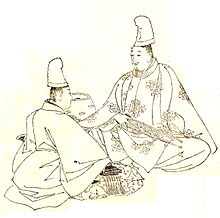
The later

The protagonist of the classical Japanese novel The Tale of Genji (The Tale of Minamoto clan)—Hikaru Genji, was bestowed the name Minamoto for political reasons by his father the emperor and was delegated to civilian life and a career as an imperial officer.
The Genpei War is also the subject of the early Japanese epic The Tale of the Heike (Heike Monogatari).[12]
Members of the Minamoto clan (Genji clan)
Even within royalty there was a distinction between princes with the title shinnō (親王), who could ascend to the throne, and princes with the title ō (王), who were not members of the line of imperial succession but nevertheless remained members of the royal class (and therefore outranked members of Minamoto clans). The bestowing of the Minamoto name on a (theretofore-)prince or his descendants excluded them from the royal class altogether, thereby operating as a reduction in legal and social rank even for ō-princes not previously in the line of succession.

Many later clans were formed by members of the Minamoto clan, and in many early cases, progenitors of these clans are known by either family name. There are also known monks of Minamoto descent; these are often noted in genealogies but did not carry the clan name (in favour of a dharma name).

The Minamoto is the ancestor and parent clan of many notable descendant clans, some of which are Ashikaga, Tokugawa, Matsudaira, Nitta, Takeda, Shimazu, Sasaki, Akamatsu, Kitabatake, Tada, Ota, Toki, Yamana, Satomi, Hosokawa, Satake, Yamamoto, Hemi, Ogasawara, Yasuda, Takenouchi, Hiraga, Imagawa, Miyake, etc.[13]
There were 21 branches of the clan, each named after the emperor from whom it descended. Some of these lineages were populous, but a few did not produce descendants.
Saga Genji
The Saga Genji are descendants of

Noted Saga Genji and descendants include:
- Minamoto no Makoto, seventh son of the Emperor
- Minamoto no Hiromu, eighth son of the Emperor
- Minamoto no Hitoshi, grandson of Hiromu
- Minamoto no Tokiwa, son of the Emperor
- Minamoto no Okoru, first son of Tokiwa
- Minamoto no Sadamu, son of the Emperor
- Minamoto no Shitagō, great-grandson of Sadamu
- Minamoto no Hiroshi, son of the Emperor
- Minamoto no Tōru, son of the Emperor
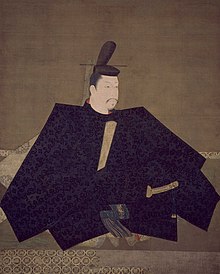
Portrait of Minamoto no Yoritomo (1147–1199) in 1179, by Fujiwara no Takanobu - Minamoto no Anbō(secular name Minamoto no Shitagō), great-grandson of Tōru
- Watanabe no Tsuna (his official name was Minamoto no Tsuna, who resided at Watanabe in Settsu province, and took the name of the place), great-great-grandson of Tōru
- Matsuura Hisashi, great-grandson of Tsuna
- Minamoto no Koreshige, grandson of Tōru
- Minamoto no Mitsusue, great-great-grandson of Koreshige
- Minamoto no Tsutomu, son of the Emperor
- Minamoto no Hiraku, son of the Emperor
History records indicate that at least three of Emperor Saga's daughters were also made Minamoto (Minamoto no Kiyohime, Minamoto no Sadahime, and Minamoto no Yoshihime), but few records concerning his daughters are known.

Ninmyō Genji
They were descendants of
Montoku Genji
These were descendants of
Seiwa Genji
These were descendants of
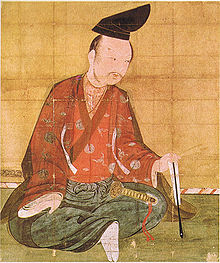
Yōzei Genji
These were descendants of Emperor Yōzei. While Minamoto no Tsunemoto is termed the ancestor of the Seiwa Genji, there is evidence (rediscovered in the late 19th century by Hoshino Hisashi) suggesting that he was actually the grandson of Emperor Yōzei rather than of Emperor Seiwa. This theory is not widely accepted as fact, but as Yōzei was deposed for reprehensible behaviour, there would have been a compelling motive to claim descent from more auspicious origins if it were the case.
Kōkō Genji
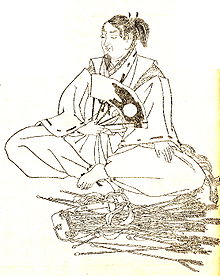
These were descendants of Emperor Kōkō. The great-grandson of his firstborn Prince Koretada, Kōshō, was the ancestor of a line of busshi, from which various styles of Buddhist sculpture emerged. Kōshō's grandson Kakujo established the Shichijō Bussho workshop.
Uda Genji
These were descendants of
.
Daigo Genji
These were descendants of
Murakami Genji
These were descendants of

Reizei Genji
These were descendants of Emperor Reizei. Though they are included among the listing of 21 Genji lineages, no concrete record of the names of his descendants made Minamoto is known to survive.
Kazan Genji
These were descendants of

Sanjō Genji
These were descendants of Emperor Sanjō's son Prince Atsuakira. Starting with one of them, Minamoto no Michisue, the position of Ōkimi-no-kami (chief genealogist of the imperial family) in the Ministry of the Imperial Household was passed down hereditarily.
Go-Sanjō Genji
These were descendants of

Go-Shirakawa Genji
This line consisted solely of Emperor Go-Shirakawa son Mochihito-ō (Takakura-no-Miya). As part of the succession dispute that led to the opening hostilities of the Genpei War, he was declassed (renamed "Minamoto no Mochimitsu") and exiled.
Juntoku Genji
These were descendants of
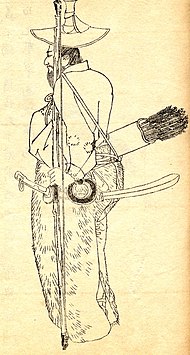
Go-Saga Genji
This line consisted solely of

Go-Fusakusa Genji
These were descendants of
Ōgimachi Genji
These were non-royal descendants of
Legacy
Historical periods and cities founding

- shōgunof Japan.
- shōgun Ashikaga Takauji—a direct descendant of Minamoto no Yoshiyasu(also known as Ashikaga Yoshiyasu).
- shōgun Tokugawa Ieyasu—who claimed to be a descendant of Minamoto no Yoshishige(also known as Nitta Yoshishige).
Shinto shrines founding

- Three Genji Shrines (源氏三神社, Genji San Jinja) - A group of Shinto shrines connected closedly with the members of Seiwa Genji branch of the Minamoto clan.
- Rokusonnō Shrine, Minami-ku, Kyoto, Kyoto Prefecture
- Tada Jinja, Kawanishi, Hyōgo Prefecture
- Habikino, Osaka Prefecture
- Sasaki Shrine (沙沙貴神社) - a Shinto shrine connected closely with the members of Uda Genji branch of the Minamoto clan.
Literature and arts
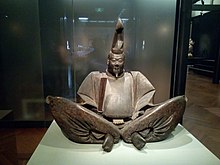
- The Tale of Genji (源氏物語, Genji monogatari, The Tale of the Minamoto clan) by Murasaki Shikibu, an important 11th-century classical Japanese novel.

Genji monogatari - The Tale of the Heike (平家物語, Heike Monogatari, The Tale of house of Taira), a 14th-century epic poetry compiled of the struggle between the Minamoto clan and the Taira clan for control of Japan at the end of the 12th century in the Genpei War (1180–1185).
See also
- Minamoto (surname)
- Minamoto Yoritomo
- Japanese clans
- History of Japan
References
- ^ a b "...the Minamoto (1192-1333)" Warrior Rule in Japan, page 11. Cambridge University Press.
- ^ ISBN 9784121025739.
- ^ ISBN 9784827312409.
- OCLC 47462068.
- ISBN 9780674017535.
- ISBN 9780520076020.
- ^ Frederic, Louis (2002). Japan Encyclopedia. Cambridge, Massachusetts: Harvard University Press.
- ISBN 978-1-4408-0394-9.
- ^ ISBN 0804705232.
- ISBN 978-0-674-01753-5.
- ISBN 978-3-7448-8682-6.
- ISBN 978-0-231-51083-7.
- ^ Papinot, Jacques Edmond Joseph (1906). Nobiliaire du Japon (PDF) (in French). Dortmund; München: Oliver Rost; Stefan Unterstein. pp. 3–73.
- ^ ISBN 978-4-8040-1075-5.


